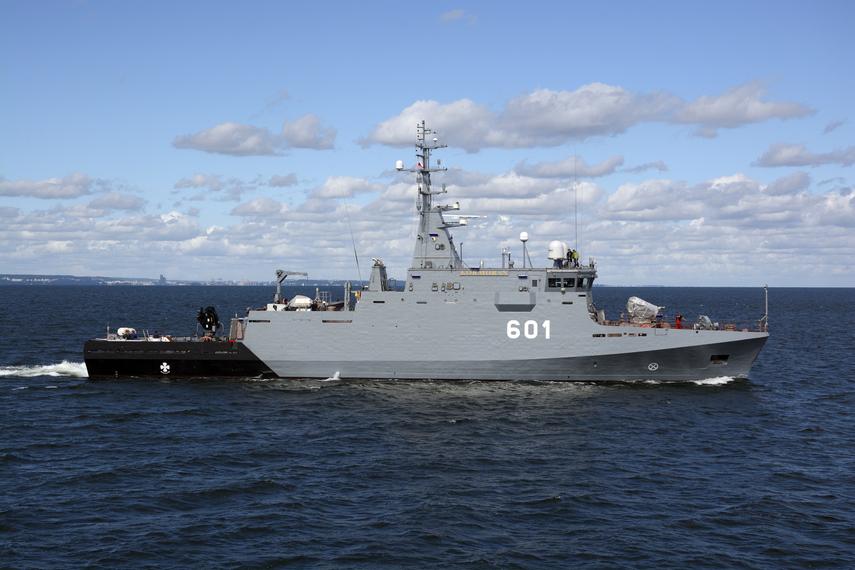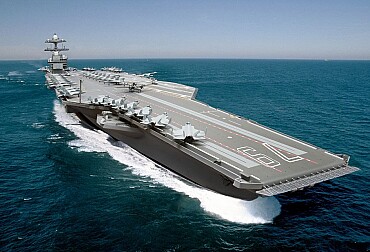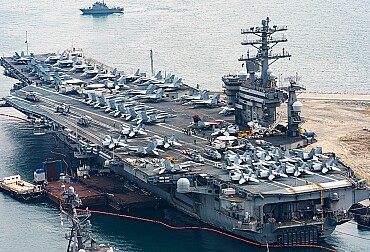Naval Acquisition Trends Among Post-Socialist NATO Members
Post-socialist NATO countries with access to the sea are at various stages of modernizing their fleets. While countries such as Poland and Romania are moving toward acquiring multipurpose "combat" surface vessels, smaller countries—from Lithuania to Albania—are focusing mainly on patrol boats and minesweepers. The common denominator is the desire to join alliance structures and build interoperable forces, albeit in different "weight" categories.
After the fall of the Iron Curtain, most post-socialist states with access to the sea inherited outdated Soviet or Yugoslavian technology that was ill-suited to the requirements of modern alliance operations. Another major trend was the purchase of ex-Cold War Western vessels.
Large countries: Poland and Romania
Among the post-socialist NATO members, two countries clearly stand out as having the ambition to move beyond coastal defense and become true regional naval powers due to their size and population: Poland and Romania. Both countries have the largest fleets among the post-socialist NATO members. At the same time, however, they face different challenges: Poland in the Baltic Sea and Romania in the Black Sea against Russian fleets.
The backbone of the Polish fleet's development is the Miecznik program, which is building three multi-purpose frigates (Wicher, Burza, Huragan) based on the British Arrowhead 140 design. These are intended to provide air and anti-submarine defense and move the Polish Navy into the ranks of medium-sized European fleets. The second pillar is the expansion of the Kormoran II series of minesweepers, which are becoming a key element of the alliance's mine clearance capacity in the Baltic Sea. Three units are currently in operation, with another three to be added in the future. At the same time, Poland is addressing an acute shortage of modern submarines—the only active unit, ORP Orzeł, is already obsolete, and the Orka program is expected to provide a replacement in the form of three new diesel-electric submarines. Overall, Warsaw is positioning itself as the main regional naval power in the eastern Baltic (apart from Russia), capable not only of protecting its coastline but also of providing NATO with multi-purpose capabilities.

Romania is trying to play a similar role in the Black Sea, but its modernization efforts are hampered by political and financial obstacles. Two Type 22 frigates, acquired from the UK, are operated with limited armament because the long-planned modernization was ultimately not carried out. Currently, the fleet is severely outdated and relies on ex-Cold War vessels of domestic, Soviet, and Western design. For this reason, the acquisition of new surface units is more than necessary. In the future, three modern frigates and several corvettes are planned as the "combat" wing of the fleet. In addition to these ambitions, two OPV 2600 patrol boats are being acquired, which, with their displacement of 2,600 tons, already correspond to large corvettes. To strengthen the fleet more quickly, a contract was also signed this year for a Turkish Hisar-class patrol boat, which is based on the Turkish Ada-class corvettes. It is interesting to note that Romania also has a submarine fleet, albeit in the form of a single Kilo-class submarine, which is effectively out of service. However, it is known that this is set to change in the foreseeable future with the purchase of two units, probably of French design.
Medium-sized countries: Croatia and Bulgaria
The second category among post-socialist navies consists of countries that, although not as large as Poland or Romania, are nevertheless striving to maintain a certain level of multi-purpose capabilities. Their fleets are somewhere between coastal defense and modernization efforts.
The Croatian Navy ranks among the medium-sized navies in the Balkans. Its characteristic feature is missile boats equipped with Swedish RBS-15 missiles, which provide real strike capacity against surface targets. The core of the current fleet consists of two domestic Kralj-class units and two older Helsinki-class units of Finnish origin. The navy also includes one ex-Yugoslav Končar-class unit. All three are missile boats. However, Croatia also has six patrol boats of the following classes: Omiš (currently two units and another four planned) and Mirna (four ex-Yugoslav units). These are supplemented by the light minesweeper Korčula. By the end of this decade, the Croatian Navy should be further strengthened by two to three multi-purpose corvettes. However, the specific type of new corvettes is not yet known.
The Bulgarian Navy has three Wielingen-class frigates (originally from the Belgian Navy) and one Koni-class frigate (Project 1159). These form the backbone of its surface combat capabilities, albeit with limitations due to the age of the weaponry and sensors. They are supplemented by three Project 1241 missile corvettes, which perform tasks against surface targets and anti-submarine/protective operations in coastal waters.
A significant change will be brought about by the Hrabri project, under which two multi-purpose modular patrol ocean-going vessels are being built in Varna as part of a 2020 contract. The Hrabri and Smeli vessels are designed for a wider range of missions – reconnaissance, patrols, and anti-submarine tasks. They are to be delivered in 2025–2026. Their arrival could significantly strengthen Bulgaria's Black Sea capabilities. Nevertheless, most of the older vessels remain technically obsolete; their armament, sensors, and overall operational condition do not match the level of some of the newer Black Sea fleets. Modernization is planned, but its pace and scope are limited by budget and logistical capacity.
Small players: Lithuania, Latvia, Estonia, Slovenia, Montenegro, and Albania
The third group consists of countries whose naval fleets are limited in size and capability. These countries—primarily Lithuania, Latvia, and Estonia in the Baltic region—focus primarily on coastal surveillance, mine countermeasures, and participation in international missions. A common feature is the emphasis on interoperability within NATO and the frequent use of second-hand vessels from larger allies.
Lithuania operates three Hunt-class minesweepers (ex-Royal Navy, Skalvis, Sūduvis, and Kuršis) and a Vidar-class minelayer. In addition to these vessels specialized in mine laying and clearance, Lithuania also has a squadron of patrol boats. These consist of four Danish Flyvefisken-class units and one Swedish Storebro SB90E patrol boat. Lithuania has ordered two Watercat M18 fast multi-purpose boats equipped with the SPIKE NLOS anti-missile system and remote-controlled machine guns. It is also considering the purchase of Vanguard-class multi-purpose modular vessels from the Norwegian company Kongsberg, which could perform various roles according to the needs of the Lithuanian Navy.
Latvia has five Alkmaar/Tripartite class minesweepers, the same number of Skrunda class patrol vessels, and one Vidar class minelayer. Latvia has joined the CFMAC (coastal force modernization) program, although specific vessel orders have not yet been publicly specified.
Estonia has three Sandown-class minesweepers (ex-British) – Admiral Cowan, Sakala, Ugandi – which constitute its main minesweeping capacity. It also has one Lindormen-class minelayer and four small patrol vessels. Estonia plans to replace its Pikker patrol vessel with a new vessel capable of performing multiple tasks: coastal surveillance, border protection, and environmental missions. The budget and basic requirements have already been set at EUR 30–40 million. Estonia is also modernizing its fleet of minesweepers and plans to acquire two new patrol vessels. The new Littoral Mission Vessel (LMV) class vessel should, if possible, be manufactured in Estonia in cooperation with foreign partners such as Saab and ST Engineering.
A common weakness of these fleets is that they do not have larger combat vessels (e.g., frigates or corvettes of a similar size), which limits their capabilities in broader naval operations.
Slovenia has the smallest independent navy in the alliance. It has one patrol boat, the Triglav, which was supplied by Russia as debt compensation. Current modernization efforts are focused on upgrading this vessel. In addition to the Triglav, the Slovenians have an Israeli Super Dvora class patrol boat. Similarly, Montenegro has several patrol vessels, among which the former Yugoslav Kotor class corvette stands out, which was adapted for patrol tasks after disarmament. Other vessels include older smaller boats and the Jadran training sailboat. On November 4, 2024, Montenegro took a step toward modernizing its maritime defense by signing a contract with the French shipyard Kership to purchase two OPV 60M class coastal patrol vessels. These vessels will be built in France and are scheduled for delivery in the first half of 2027. The vessels will be named Petar I Njegoš and Petar II Njegoš, in honor of an important ruler and cultural symbol of Montenegro. The project is part of a defense agreement between France and Montenegro and is supported by the French Defense Procurement Agency (Direction Générale de l’Armement) and BPI France. The vessels are being built at the Kership shipyard in Lorient, where construction of the first vessel began on April 24, 2025.
The Albanian Navy has undergone modernization and today forms a key component of maritime security in the region. Its main strength lies in four Iliria-class patrol vessels, built to the Damen Stan Patrol 4207 design. The first of these, Iliria, was commissioned in 2008 and built in the Netherlands, while the other three – Oriku, Lisus, and Butrinti – were built in Albania. These vessels are designed to protect the coastline, combat smuggling, and carry out search and rescue missions. In 2025, Albania received a Cassiopea-class patrol boat from Italy, renamed P 133, which strengthened its maritime defense capabilities and participation in NATO missions.
Albania no longer has any operational submarines. In the past, it owned four Whiskey-class diesel-electric submarines, which were built in the former Soviet Union. After 1997, three of them were scrapped and the fourth, Stuhia (No. 516), was left at the Pashaliman base, which was offered to NATO as a potential base in 2022. Albania currently has no plans to acquire submarines or heavier combat ships. Its naval forces are focusing on modernizing existing vessels and strengthening cooperation with NATO.
These "small fleets" thus demonstrate a pragmatic approach: they focus on specialization within the alliance, coastal security, and international cooperation. Instead of expensive frigates or corvettes, they invest in smaller vessels that are cheaper to operate but still allow for participation in alliance structures—especially in the areas of mine clearance and patrols.
Analysis of acquisition trends
The naval acquisition trends of post-socialist NATO members reflect a combination of geographical, economic, and security realities that shape their strategic priorities. While all these countries share the goal of full interoperability with Alliance forces, differences between the Baltic, Black, and Adriatic Seas create distinct modernization models.
The Baltic Sea is characterized by enclosed waters and a strong NATO presence, leading to a preference for smaller, highly specialized vessels. Poland is an exception here—it is the only country in the region that owns and is building a "frigate" navy capable of conducting complex air and anti-submarine defense operations. The other Baltic countries – Lithuania, Latvia, and Estonia – focus on minesweepers, patrol boats, and modular multi-purpose units that provide coastal protection rather than power projection. This creates an imbalance: Poland is moving towards a full-fledged navy, while the rest of the "monitored" region remains within the framework of a "small fleet for collective security."
The Black Sea is the area with the greatest strategic pressure, as NATO faces the threat of the Ukrainian conflict spreading there. At the same time, the balance of power is four-dimensional – Russia, Ukraine, "problematic" Turkey, and NATO in the form of Bulgaria and Romania. This is one of the reasons why the latter two countries are striving to maintain multi-purpose capabilities. Currently, these efforts are reflected in the purchase of patrol boats with a displacement equivalent to large corvettes, although ambitions (especially in the case of Romania) are much higher.
The Adriatic Sea is completely different – rather than an area of confrontation, it is an area of cooperation and stabilization. Croatia is the only player here with real strike capacity (missile boats and planned corvettes), while the smaller states – Slovenia, Montenegro, and Albania – function de facto as coast guards in alliance uniform. Their ships are mainly used for surveillance, combating smuggling, and rescue operations. The maritime balance in the Adriatic Sea is thus more cooperative than confrontational, with the emphasis shifting from military force to integrated security.
From a broader perspective, post-socialist fleets can be divided according to their ambitions and resources:
- Frigate navy: Poland and (aspirational) Romania – striving for multi-purpose forces capable of full participation in alliance operations. The problematic member of this group is Bulgaria, which currently owns aging frigates, but its budget does not allow for the acquisition of new modern vessels of this "weight" class, and so it risks having to scale back its military capabilities in the future.
- Corvette navy: Croatia (and possibly Bulgaria in the future) – combines coastal defense and limited power projection.
- Patrol navy: Baltic and Adriatic microstates – focus on specialization (minesweepers, patrols, SAR) and interoperability within NATO.
Overall, it can be said that the post-socialist NATO states are pursuing an asymmetrical, rather than a uniform, path to modernization. Geographical location, economic capabilities, and the environment of individual threats shape their maritime identity more than historical heritage. The common denominator remains the desire to participate in the alliance structure not only as "security consumers" but as active contributors within their capabilities – whether aboard a frigate or a patrol boat.








